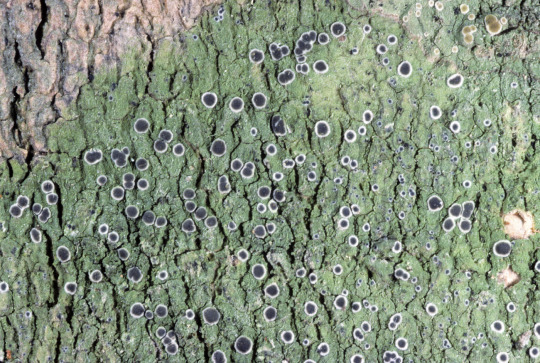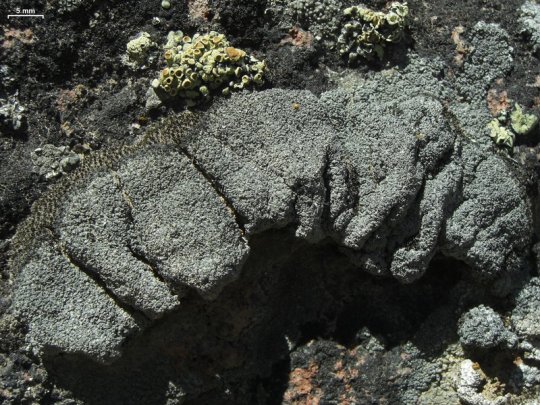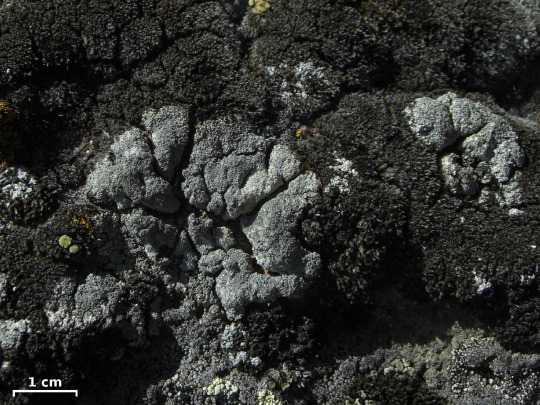Budding lichenologist (pun intended) and ornithologist hoping to educate both you and herself on lichens
Don't wanna be here? Send us removal request.
Text




Rinodina turfacea
Tundra pepper-spore lichen, rotten pepper-spore lichen
images: source | source
#lichen#lichens#lichenology#lichenologist#mycology#ecology#biology#fungi#fungus#nature#Rinodina turfacea#Rinodina#trypo#trypophobia#I'm lichen it#lichen a day#daily lichen post#lichen subscribe#symbiosis#symbiotic organisms#algae#life science#environmental science#natural science#the natural world#beautiful nature#weird nature
50 notes
·
View notes
Text









Physconia leucoleiptes
Yellowish bottle-brush lichen, bottle-brush frost lichen
images: source | source | source
#lichen#lichens#lichenology#lichenologist#mycology#ecology#biology#fungi#fungus#nature#the natural world#beautiful nature#naturecore#Physconia leucoleiptes#Physconia#I'm lichen it#lichen a day#daily lichen post#lichen subscribe#life science#environmental science#trypo#trypophobia#go outside#take a hike#look for lichens
52 notes
·
View notes
Note
hello lichenaday! i just wanted to say that it's super awesome and refreshing to see people passionate about semi niche ecological stuff like lichen!! your posts are always a delight and help me to remember to appreciate how much life there is in the world around me! i get so excited when i see a lichen around me in the wild and it's genuinely such a bright spot in my day. so thank you for sharing really cool stuff!!
Semi-niche? I will have you know I consider my interests to be incredibly niche lol. But thank you, I appreciate the support. And I hope you continue to find more around you in the world to love and cherish.
39 notes
·
View notes
Note
Your photos are beautiful but they have me curious, what country do you live in?
I currently live in Munich, Germany, and I travel a lot (mostly for fun, some for work). My photos were taken in Germany, Malta, Albania, Spain, Andorra, and France. I am not the best photographer, but I am good at finding gorgeous subjects.
#not lichens#This year has already been a lot of traveling#with more scheduled for the near future#photography#nature
44 notes
·
View notes
Text
More because 10 was not enough:










1. Erinaceus europaeus, European hedgehogs
2. Graphosoma italicum italicum, Continental striped shield bug
3. Psammodromus algirus, Large psammodromus
4. Neottiura bimaculata
5. Panthea coenobita, Pine arches moth
6. Elophila nymphaeata, Brown China mark--larvae
7. Gentiana verna, Spring gentian
8. Dactylorhiza sambucina, Elder-flowered orchid
9. Narcissus poeticus, Poet's narcissus
10. Erodium glandulosum
While I'm out looking for lichens, I also look for other things on occasion. A few of my favorite observations from this year so far:










1. Pseudoplectania nigrella, Ebony cup
2. Romulea variicolor, Maltese sand crocus
3. Anacamptis pyramidalis urvilleana, Maltese pyramidal orchid
4. Tarentola mauritanica, Moorish gecko
5. Testudo hermanni, Hermann's tortoise
6. Latipalpis plana
7. Philaeus chrysops, Red-bellied jumping spider
8. Natrix natrix, Grass snake
9. Salamandra atra, Alpine salamander
10. Cypripedium calceolus, Lady's slipper orchid
#bugs#fungi#spiders#hedgehog#herps#lizard#gecko#snake#spider#bug#beetle#flowers#flower#orchid#gentian#narcissus#salamander#tortoise#alpine#alps#Andorra#Munich#France#Germany#pyrenees mountains
217 notes
·
View notes
Text
While I'm out looking for lichens, I also look for other things on occasion. A few of my favorite observations from this year so far:










1. Pseudoplectania nigrella, Ebony cup
2. Romulea variicolor, Maltese sand crocus
3. Anacamptis pyramidalis urvilleana, Maltese pyramidal orchid
4. Tarentola mauritanica, Moorish gecko
5. Testudo hermanni, Hermann's tortoise
6. Latipalpis plana
7. Philaeus chrysops, Red-bellied jumping spider
8. Natrix natrix, Grass snake
9. Salamandra atra, Alpine salamander
10. Cypripedium calceolus, Lady's slipper orchid
#not lichens#naturalist#creatures#biologist#ecology#biology#bugs#spider#snake#flowers#orchid#orchids#gecko#tortoise#salamander#hiking#botanizing#botany#the Maltese endemics made me so happy#and any time you see a herp is a good time#endemic species#Malta#Albania#Germany#Bavaria#Alps#Spain
217 notes
·
View notes
Text










Petractis clausa
A lot of lichens are difficult to differentiate from one another, and so when you see one that is so distinct and nearly impossible to confuse with a another, it is like, so delicious. So choice. So delectable. P. clausa is a crustose lichen that grows on calcareous rocks in sheltered, humid woodlands and gorges in Europe. It has an endolithic (immersed in rock) thallus that colors the rock pale whitish-yellow topped by pale pink-orange apothecia. These apothecia start out deeply immersed and flaks-shaped with the disc sunk well below the thick margin, but in time this margin will spread and crack radially in 5-9 segments, revealing the orange disc inside. And if all that wasn't cool enough, P. clausa has a rare Scytonema cyanobacterial photobiont. It is rare and likely declining in Europe due to habitat loss and fragmentation, but you bet I will be looking for it at my Alpine lichenology conference in the Italian Alps next week!
images: source | source
info: source | source | source
#Petractis clausa#Petractis#lichen#lichens#lichenologist#lichenology#mycology#ecology#biology#fungi#fungus#nature#symbiosis#cyanobacteria#trypo#trypophobia#I'm lichen it#lichen a day#daily lichen post#lichen subscribe#life science#environmental science#natural science#the natural world#beautiful nature#weird nature#lichens are so good#look for lichens
65 notes
·
View notes
Text










Ramalina scoparia
Broom ribbon lichen
This fruticose lichen grows in short, tufted bundles of flattened, strap-like lobes on costal rocks along either side of the Bering Strait in Alaska and Siberia. The branches are lax and partially hollow, with the pale yellow cortex breaking open near the ends to produce yellowish, granular soredia. R. scoparia is very similar to R. kurokawae, but the 2 differ in chemistry and range (the latter is found in Japan and China). BUT if you combine the ranges of the 2 species, it forms a continuous path from North America to eastern Asia, perhaps revealing the historic dispersal patterns of Ramalinas in this corner of the world!
images: source
info: source | source
#lichen#lichens#lichenology#lichenologist#mycology#ecology#biology#fungi#nature#fungus#Ramalina scoparia#Ramalina#symbiosis#symbiotic organisms#algae#trypo#trypophobia#I'm lichen it#lichen a day#daily lichen post#lichen subscribe#life science#environmental science#natural history#evolution
93 notes
·
View notes
Text







Rhizocarpon cookeanum
Cooke's map lichen
images: source | source | source
#lichen#lichens#lichenology#lichenologist#mycology#ecology#biology#fungi#fungus#Rhizocarpon cookeanum#Rhizocarpon#trypo#trypophobia#I'm lichen it#lichen a day#daily lichen post#lichen subscribe#symbiosis#symbiotic organisms#algae#crustose lichen#map lichen#life science#environmental science#natural science#nature#the natural world#beautiful nature#weird nature
281 notes
·
View notes
Text






Nephromopsis fendleri (syn. Tuckermanella fendleri)
Dwarf wrinkle lichen
images: source
#lichen#lichens#lichenology#lichenologist#mycology#ecology#biology#fungi#fungus#nature#trypo#trypophobia#I'm lichen it#lichen a day#daily lichen post#lichen subscribe#Nephromopsis fendleri#Nephromopsis#symbiosis#symbiotic organisms#algae#life science#environmental science#natural science
172 notes
·
View notes
Text








Byssoloma meadii
This lichen grows on hardwood bark in low-elevation, costal plains and swamps, and occasionally in humid upland forests. It has a continuous to scurfy, blue-green to olive green thallus surrounded by a white prothallus. It has distinctive apothecia which all have a white, cottony margin surrounding a yellow to brown disc. B. meadii appears to be restricted to SE North America, but it may have thus far been overlooked in scattered microhabitats elsewhere.
images: source | source | source
info: source | source
#lichen#lichens#lichenology#lichenologist#mycology#ecology#biology#fungi#nature#fungus#symbiotic organisms#symbiosis#algae#trypo#trypophobia#Byssoloma meadii #Byssoloma#i'm lichen it#lichen a day#daily lichen post#lichen subscribe#life science#environmental science#natural science#beautiful nature#weird nature#see the forest for the lichens
86 notes
·
View notes
Text









Cladonia hammeri
This lichen has a squamulose (scale-like) basal thallus topped in 4-10 mm tall, goblet-shaped podetia (hollow stalks). The surface of the podetia is granular, and white-gray to gray-green in color. Only rarely will you find small, globose, dark brown apothecia along the cup margins. C. hammeri grows on arid soil in SW North America.
images: source | source
info: source
#lichen#lichens#lichenology#lichenologist#mycology#ecology#biology#fungi#fungus#nature#trypo#trypophobia#symbiosis#symbiotic organisms#algae#Cladonia hammeri#Cladonia#pixie cups#fairy goblets#the natural world#beautiful nature#weird nature#tiny worlds#I'm lichen it#lichen a day#daily lichen post#lichen subscribe#lichen describe
75 notes
·
View notes
Text







Sagedia mastrucata
This crustose lichen has a pale to dark gray, placodioid (areolate (tile-like) in the center and lobate around the margin) thallus. It has bullate (blister-like) to papillose (nipple-like outgrowths) areoles, and produces bullate isidioid outgrowths along the margins. I can't define "isidioid" simply, so look it up if you are curious. It has immersed apothecia with black discs and thin, thalline margins. S. mastrucata grows on rocks at high elevations in North America and Europe, likely with a wider distribution (and maybe more species) yet to be discovered.
images: source | source | source
info: source
#lichen#lichens#lichenology#lichenologist#mycology#ecology#biology#fungi#fungus#nature#Sagedia mastrucata#Sagedia#trypo#trypophobia#lichen a day#daily lichen post#lichen subscribe#i'm lichen it#life science#environmental science#natural science#symbiosis#symbiote
58 notes
·
View notes
Text











Omphalora arizonica
Potato-chip lichen
People ask me all the time if you can eat lichens. For most lichens you *can* eat them, but they just aren't very delicious or particularly nutritious. I think the better question is *should* you eat lichens, and the answer is generally NO. So knowing that, what smart guy decided to start calling the critically endangered O. arizonica potato-chip lichen? Basically BEGGING for it to be eaten? I don't know but please, if you come across this dude and think "mmmm, cronchy . . . " just leave him be, OK? This umbilicate foliose lichen grows on cliff and vertical rock faces at high elevations in SW USA. It can grow up to 20 cm in diameter, but usually can be found in round, folded bunched 5-10 cm across. The upper surface is yellow and ridged, with round papillae surrounding punctiform (dot-like) pseudocyphellae (areas of the cortex lacking algal cells so as to appear paler than the rest of the surface). The lower surface is dark blue-green to black, and covered in more papillate pseudocyphellae and tubercles. It produces lots of apothecia, which have a red-brown disk and prominent margin. O. arizonica has a patchy, unpredictable distribution, and was once likely more widespread according to historical records, but whatever factors have caused its decline are still not understood. Like with so many lichens, more research is needed to fully elucidate its specific niche, and measures should be taken to protect these lil rock snacks until we know more.
images: source | source
info: source | source
#lichen#lichens#lichenology#lichenologist#mycology#ecology#biology#fungi#fungus#symbiosis#symbiotic organisms#algae#trypo#trypophobia#Omphalora arizonica#Omphalora#potato chip lichen#I'm lichen it#lichen a day#daily lichen post#lichen subscribe#beautiful nature#weird nature#natural science#environmental science#life science#go outside#look for lichens#lichens are so good#grow wherever the fuck you want
474 notes
·
View notes
Note
I initially followed you just because I thought lichens are pretty. But lately I’ve become very interested in learning more about them and trying to ID the ones that I see!! My morning walks end up just being a chance for me to look at lichen. My most observed species on iNat are all lichens now. I’m having so much fun learning about something that I had previously never paid much attention to!!!
When I tell someone what I do and then they are like "uh ok, what are lichens? What do they do? Why should I care?" I get so excited I start to vibrate. "Buckle up, cowboy, I'm about to blow your mind!" and then it's just me excitedly info dumping while their eyes glaze over. So thank you for being one of the people who appreciates the online info dumping I do, and I hope you continue to keep an eye out for all the little guys out there waiting patiently to be appreciated.
59 notes
·
View notes
Text





Acarospora hospitans
images: source | source | source
22 notes
·
View notes
Note

This is THE photo that got me interested in lichen!! Usnea strigosa complex, seen in northern GA.
Little muppety-arm creature!!!
64 notes
·
View notes